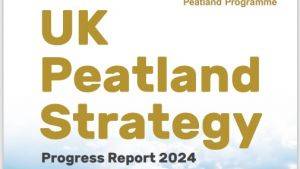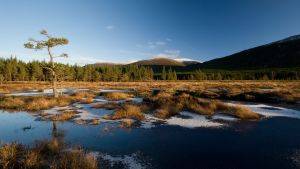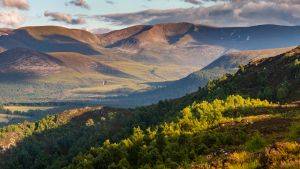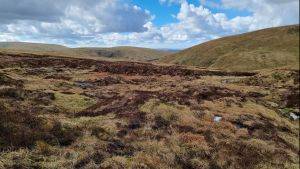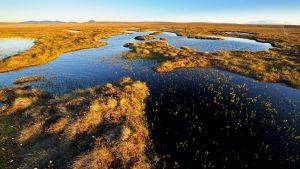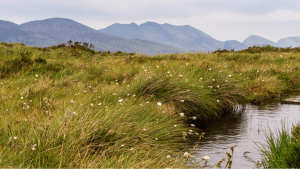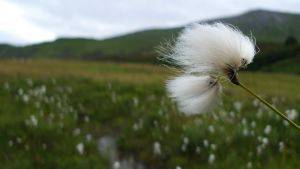Bleaklow (MoorLIFE Project)
Introduction
Led by the Moors for the Future Partnership, the MoorLIFE moorland restoration project aimed to restore 800 ha of Bleaklow to the healthy wet bog it should be.
The MoorLIFE project was made possible by a £5.5m grant from the European Union’s LIFE+ programme. Protecting active blanket bog by restoring bare and eroding peat in the South Pennines Special Area of Conservation (SAC) and Special Protection Area (SPA) was key to its success.
Description
Owned by National Trust, United Utilities and Woodhead Estate, Bleaklow covers 5,400 ha and is situated between Glossop and the Longdendale and Upper Derwent valleys. It includes Bleaklow Head, which at 633 metres above sea level, is the second highest plateau in the Peak District.
The Bleaklow landscape is an extraordinary one; hectare after hectare of moorland was stripped of almost all vegetation, showing nothing more than bare black peat before the MoorLIFE project took it under restoration management.
Bleaklow can be accessed from the Snake Pass or Woodhead Pass and lies on the Pennine Way and above the Trans-Pennine Trail.
Restoration Delivered
Bare peat areas on the site have been re-stabilised by installing 52 km's of geotextiles and helicoptering in 11,000 bags of heather cuttings (brash) and spreading them, to re-establish plant growth.
To kick-start the re-vegetation process, 1,900 tonnes of lime and fertiliser was applied and 22 tonnes of grass and heather seeds sown. Additionally, 150,000 moorland plants such as bilberry and cotton grass were introduced, as well as a futher 30,000 plug plants and 807 million fragment of Sphagnum.
As part of the gully blocking exercise, 4,000 dams were installed.
Site Activity
The Moors for the Future Partnership project has come up with various ways of rewetting the bogs and giving them back a proper clothing of vegetation. Specially harvested heather ‘brash’ is spread on the peat, providing a protective blanket for grass seed to take root. Lime is put down, to try to neutralise the excessively acidic nature of the soil, caused by past atmospheric pollution. Helicopters are used to drop grass seed; gullies are blocked and geotextiles laid. The spongy Sphagnum moss – the sign of a healthy wet bog – is reintroduced along with native plug plants. Little by little, the bare surface of the moors around Bleaklow is turning green once again.
Background Information
Bleaklow and the surrounding area demonstrates the result of two centuries of airborne pollution carried over from the industrial areas to the west of the Pennines, combined with the effects of wild fires. Where you would expect to find healthy wet bogs complete with a wide variety of creeping shrubs and mosses, there is instead a desert-type environment. As Chris Dean of Moors for the Future states, “it is a situation which has to be changed”.
It isn’t only the ecology which suffers when peat bogs dry out and crumble away. As well as storing incredible amounts of carbon, the drinking water for many of the big cities of northern England comes off Bleaklow and the neighbouring Pennine hills. However, treacle-coloured water carrying small particles of peat from degraded peatlands increases treatment costs for water companies and, as a result, for all of us. Bleaklow is just one of four MoorLIFE sites. The sites are Black Hill, Turley Holes and Rishworth Common.
MoorLIFE’s scale and success is very much the result of partnership working. The project was co-ordinated by the Peak District National Park, delivered by Moors for the Future Partnership and co-funded by the European Commission’s Life+ Programme. Partners included Environment Agency, Natural England, National Trust, United Utilities and Yorkshire Water.
Monitoring
Hundreds of vegetation quadrats and manual dipwells have been set-up to monitor the impact of the conservation works on plants and water table. This will provide key data for future policy and conservation work plans. In addition, local, regional and national communication initiatives are being delivered to reach different audiences and transfer knowledge, both through new media and traditional communication vehicles.
Project Name: Bleaklow (MoorLIFE Project)
Organisation / Lead partner: Moors for the Future Partnership
Location: Peak District National Park
Approximate area covered: 383 ha
Conservation Status: Special Area of Conservation (SAC), Special Protection Area (SPA), National Park (NP)
Predominately: Upland
Peat Habitats: Blanket bog
Project Type: Restoration, Management, Research
Year Project Began: 2010
Project End Date: 2015



